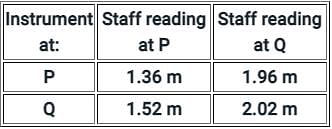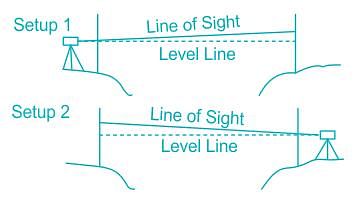Test: Reciprocal Levelling - Civil Engineering (CE) MCQ
10 Questions MCQ Test Geomatics Engineering (Surveying) - Test: Reciprocal Levelling
Which of the following type of levelling is necessary across a river ravine or any obstacle requiring a long site between two points?
Statement I): Reciprocal levelling is adopted to decide the difference of level between two points, a considerable distance apart, with great precision.
Statement II): Reciprocal levelling eliminates errors due to curvature, refraction and collimation.
Statement II): Reciprocal levelling eliminates errors due to curvature, refraction and collimation.
In reciprocal levelling, the error which is not completely eliminated, is due to:
The following observations were taken during reciprocal levelling to find the difference in elevation between two points P and Q, located on either banks of a wide river. If the reduced level of the point P is +60 m, determine the reduced level of the point Q?

Reciprocal levelling eliminate the effect of:
- Errors due to atmospheric refraction
- Errors due to earth’s curvature
- Errors in staff reading
- Errors due to collimation line
Which of these statements are correct?
Which of the following type of levelling is used when two points so situated that no place for the level can be found from which the lens of foresight and backsight will be even approximately equal?
When an instrument is at P the staff readings on P is 1.824 and on Q is 2.748. When the instrument at Q the staff readings on P is 0.928 and Q is 1.606. Distance between P and Q is 1010 mts. R.L. of P is 126.386. Find true R.L. of Q?
When an instrument is at P the staff readings on P is 1.824 and on Q is 2.748. When instrument at Q the staff readings on P is 0.928 and Q is 1.606. Distance between P and Q is 1010 mts. R.L. of P is 126.386. Find the error due to collimation?
When instrument is at P the staff readings on P is 2.748 and on Q is 1.824 when instrument at Q the staff readings on P is 1.606and Q is 0.928. Distance between P and Q is 1010 mts. R.L. of P is 126.386. Find combined effect correction for curvature and refraction?
When instrument is at P the staff readings on P is 1.824 and on Q is 2.748. When instrument at Q the staff readings on P is 0.928 and Q is 1.606. Distance between P and Q is 1010 mts. R.L. of P is 126.386. Find combined correction for curvature and refraction?
|
19 videos|32 docs|35 tests
|





















